Automatic Segmentation and Classification System for Foliar Diseases in Sunflower
Abstract
:1. Introduction
2. Materials and Methods
2.1. Dataset
2.2. Image Annotations
2.3. Proposed System for Automatic Segmentation and Classification
2.3.1. Faster R-CNN and Mask R-CNN Models Used for Segmentation
2.3.2. ResNet Model Used for Classification
3. Results
3.1. Segmentation of Lesions with Mask R-CNN and Faster R-CNN
3.2. Disease Classification Based on Field Images and CNN
3.3. Disease Classification Based on Images with Lesions and CNN
3.4. Segmentation and Classification System
4. Discussion
Author Contributions
Funding
Institutional Review Board Statement
Informed Consent Statement
Data Availability Statement
Conflicts of Interest
References
- Sadiku, M.N.; Omotoso, A.A.; Musa, S.M. Green Agriculture. Int. J. Trend Sci. Res. Dev. 2020, 4, 69–70. [Google Scholar]
- Radoglou-Grammatikis, P.; Sarigiannidis, P.; Lagkas, T.; Moscholios, I. A compilation of UAV applications for Precision Agriculture. Comput. Netw. 2020, 172, 107148. [Google Scholar] [CrossRef]
- Dawod, R.G.; Dobre, C. Resnet interpretation methods applied to the classification of Foliar Diseases in sunflower. J. Agric. Food Res. 2022, 9, 100323. [Google Scholar] [CrossRef]
- Barbedo, J.G.A. Plant disease identification from individual lesions and spots using deep learning. Biosyst. Eng. 2019, 180, 96–107. [Google Scholar] [CrossRef]
- Sharma, P.; Berwal, Y.P.; Ghai, W. Performance analysis of deep learning CNN models for disease detection in plants using image segmentation. Inf. Processing Agric. 2020, 7, 566–574. [Google Scholar] [CrossRef]
- Chan, T.; Vese, L. An active contour model without edges. In Scale-Space Theories in Computer Vision; Springer: Berlin/Heidelberg, Germany, 1999; pp. 141–151. [Google Scholar]
- Sezgin, M.; Sankur, B. Survey over image thresholding techniques and Quantitative Performance Evaluation. J. Electron. Imaging 2004, 13, 146. [Google Scholar]
- Storey, G.; Meng, Q.; Li, B. Leaf disease segmentation and detection in apple orchards for precise smart spraying in sustainable agriculture. Sustainability 2022, 14, 1458. [Google Scholar] [CrossRef]
- Lück, S.; Strickert, M.; Lorbeer, M.; Melchert, F.; Backhaus, A.; Kilias, D.; Seiffert, U.; Douchkov, D. “Macrobot”: An automated segmentation-based system for powdery mildew disease quantification. Plant Phenomics 2020, 2020, 839856. [Google Scholar] [CrossRef] [PubMed]
- Quoc, T.T.; Linh, T.T.; Minh, T.N. Comparing U-Net convolutional network with mask R-CNN in Agricultural Area segmentation on satellite images. In Proceedings of the 2020 7th NAFOSTED Conference on Information and Computer Science (NICS), Hochiminh, Vietnam, 26–27 November 2020. [Google Scholar]
- Tassis, L.M.; Tozzi de Souza, J.E.; Krohling, R.A. A deep learning approach combining instance and semantic segmentation to identify diseases and pests of coffee leaves from in-field images. Comput. Electron. Agric. 2021, 186, 106191. [Google Scholar] [CrossRef]
- Atila, Ü.; Uçar, M.; Akyol, K.; Uçar, E. Plant Leaf disease classification using EfficientNet Deep Learning Model. Ecol. Inform. 2021, 61, 101182. [Google Scholar] [CrossRef]
- Li, L.; Zhang, S.; Wang, B. Plant disease detection and classification by Deep Learning—A Review. IEEE Access 2021, 9, 56683–56698. [Google Scholar] [CrossRef]
- Khalifa, N.E.; Loey, M.; Mirjalili, S. A comprehensive survey of recent trends in Deep Learning for digital images augmentation. Artif. Intell. Rev. 2021, 55, 2351–2377. [Google Scholar] [CrossRef] [PubMed]
- Lu, Y.; Chen, D.; Olaniyi, E.; Huang, Y. Generative Adversarial Networks (gans) for image augmentation in agriculture: A systematic review. Comput. Electron. Agric. 2022, 200, 107208. [Google Scholar] [CrossRef]
- Lin, T.-Y.; Maire, M.; Belongie, S.; Hays, J.; Perona, P.; Ramanan, D.; Dollár, P.; Zitnick, C.L. Microsoft Coco: Common Objects in Context. Computer Vision–ECCV 2014. In Proceedings of the 13th European Conference, Zurich, Switzerland, 6–12 September 2014; pp. 740–755. [Google Scholar]
- Dutta, A.; Zisserman, A. The VIA annotation software for images, audio and video. In Proceedings of the 27th ACM International Conference on Multimedia, Nice, France, 21–25 October 2019. [Google Scholar]
- Make Sense. Available online: http://www.makesense.ai/ (accessed on 29 August 2021).
- Ren, S.; He, K.; Girshick, R.; Sun, J. Faster R-CNN: Towards real-time object detection with region proposal networks. IEEE Trans. Pattern Anal. Mach. Intell. 2017, 39, 1137–1149. [Google Scholar] [CrossRef] [PubMed] [Green Version]
- He, K.; Gkioxari, G.; Dollar, P.; Girshick, R. Mask R-CNN. In Proceedings of the 2017 IEEE International Conference on Computer Vision (ICCV), Venice, Italy, 22 October 2017. [Google Scholar]
- He, K.; Zhang, X.; Ren, S.; Sun, J. Deep residual learning for image recognition. In Proceedings of the 2016 IEEE Conference on Computer Vision and Pattern Recognition (CVPR), Las Vegas, NV, USA, 27–30 June 2016. [Google Scholar]
- Xie, S.; Girshick, R.; Dollar, P.; Tu, Z.; He, K. Aggregated residual transformations for deep neural networks. In Proceedings of the 2017 IEEE Conference on Computer Vision and Pattern Recognition (CVPR), Honolulu, HI, USA, 21–26 July 2017. [Google Scholar]
- Lin, T.-Y.; Dollar, P.; Girshick, R.; He, K.; Hariharan, B.; Belongie, S. Feature Pyramid Networks for Object Detection. In Proceedings of the 2017 IEEE Conference on Computer Vision and Pattern Recognition (CVPR), Honolulu, HI, USA, 21–26 July 2017. [Google Scholar]
- Wu, Y.; Kirillov, A.; Massa, F.; Lo, W.Y.; Girshick, R. Facebookresearch/Detectron2: Detectron2 Is a Platform for Object Detection, Segmentation, and Other Visual Recognition Tasks. Available online: https://github.com/facebookresearch/detectron2 (accessed on 1 August 2021).
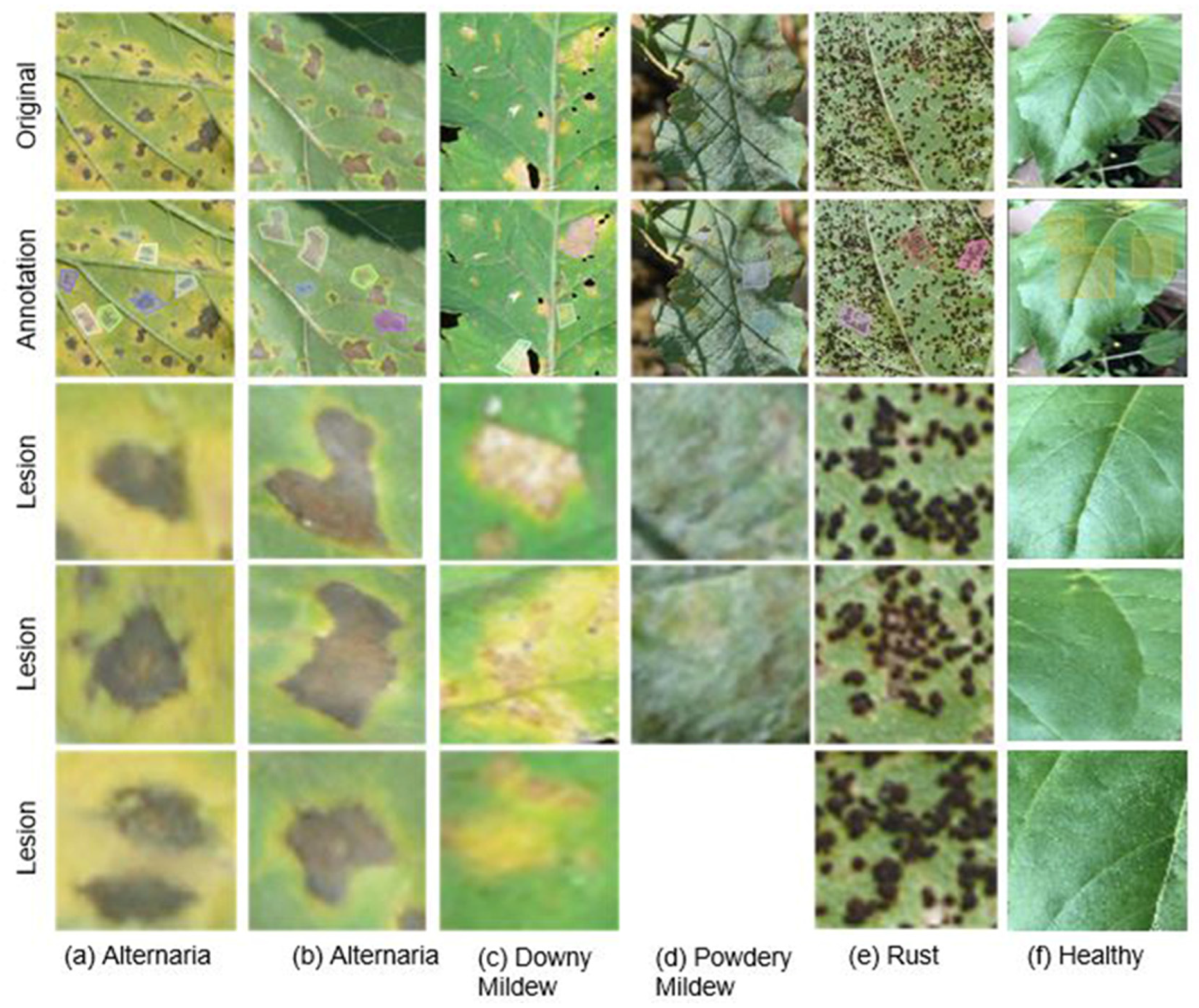
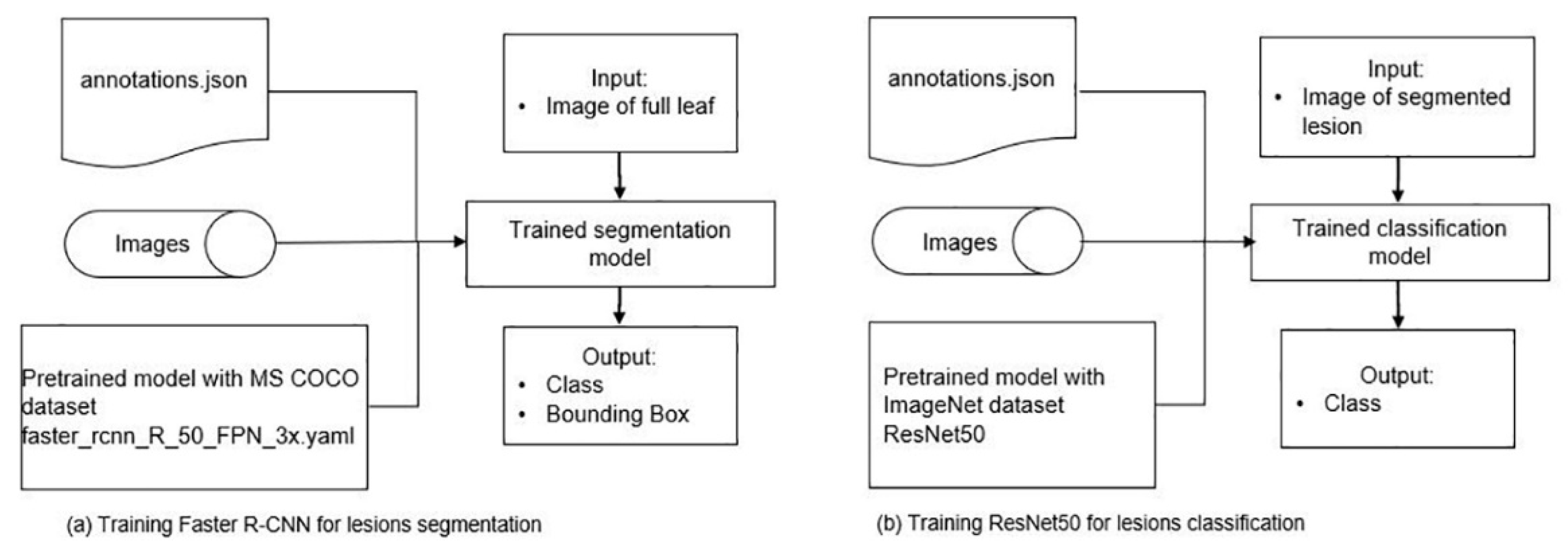

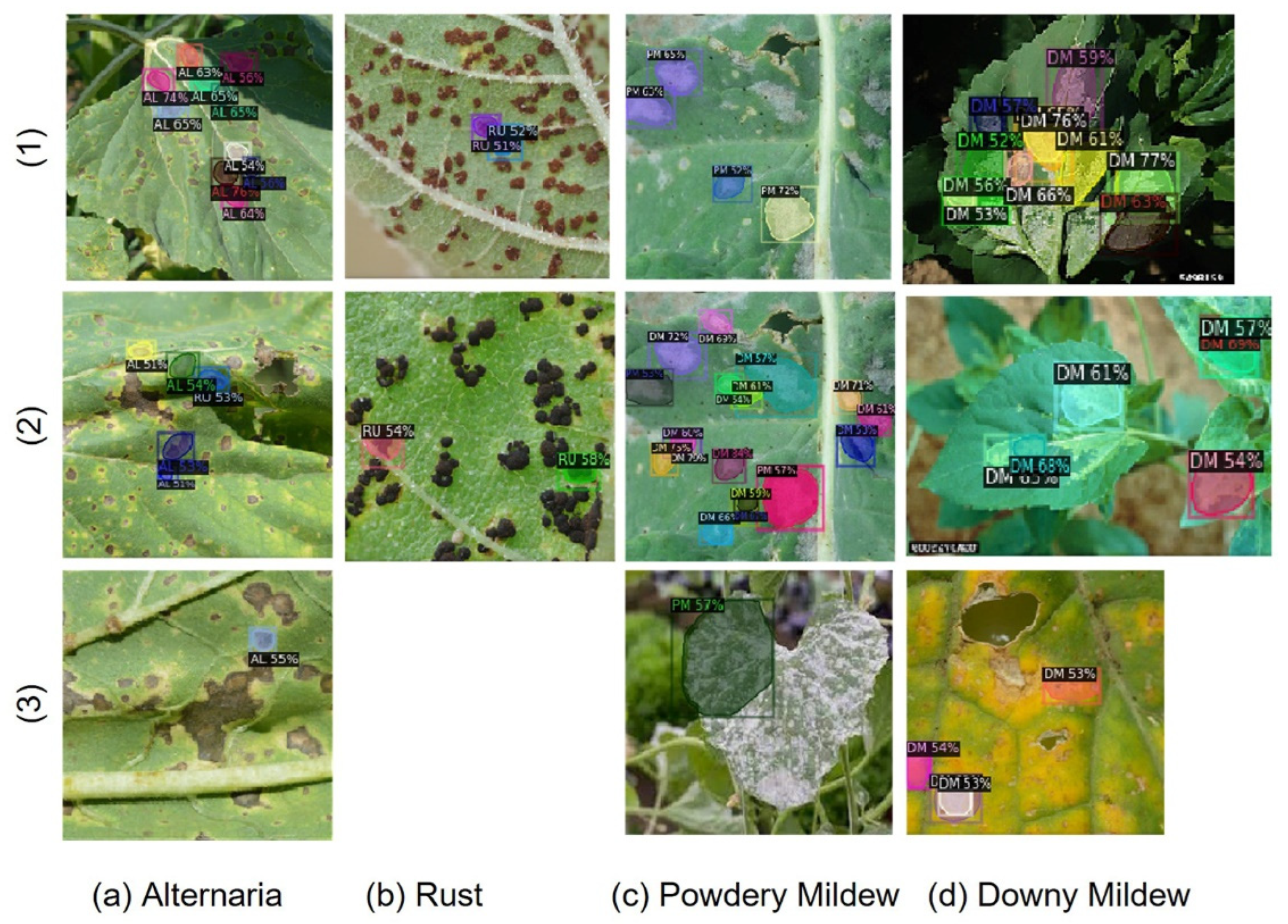

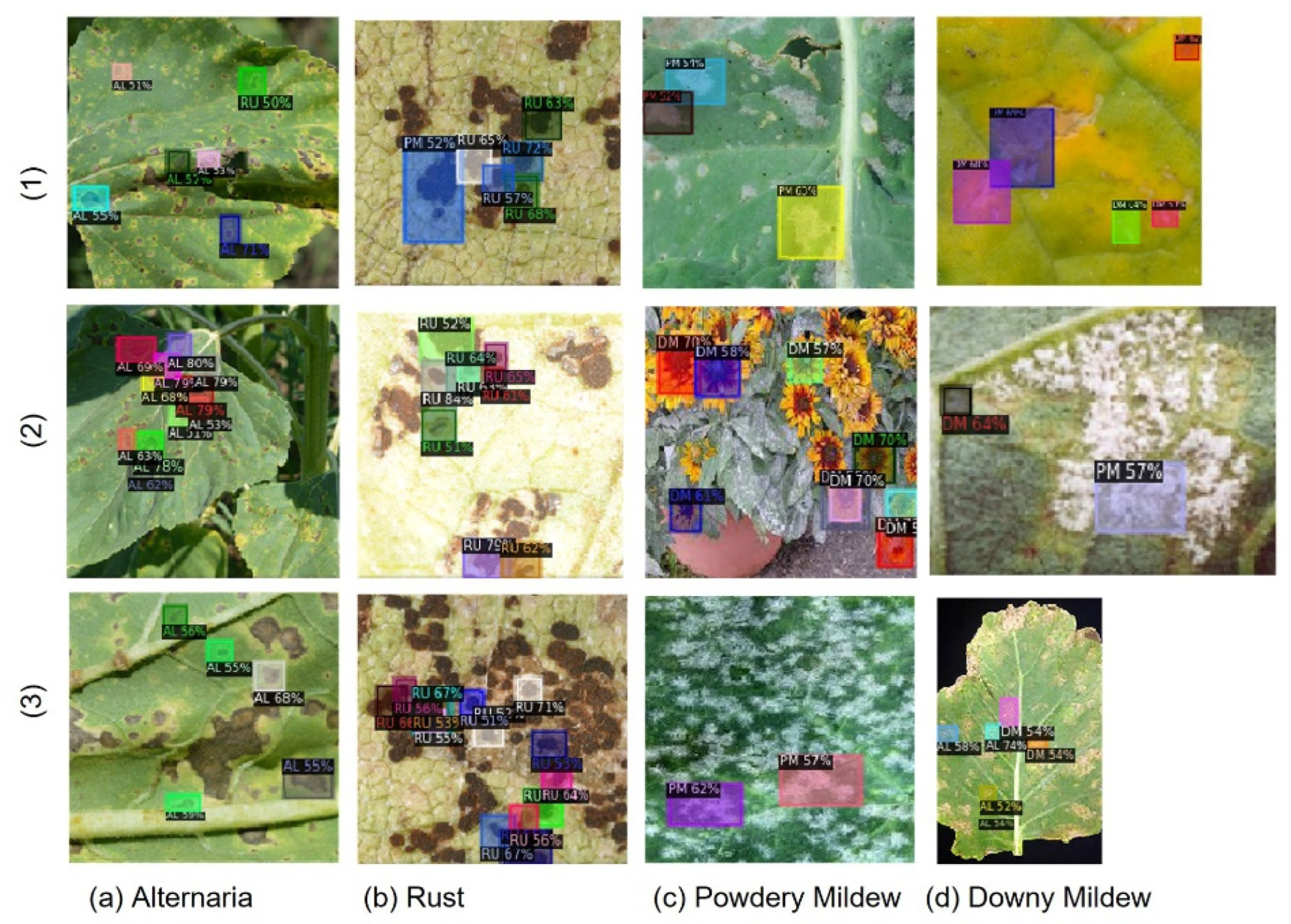


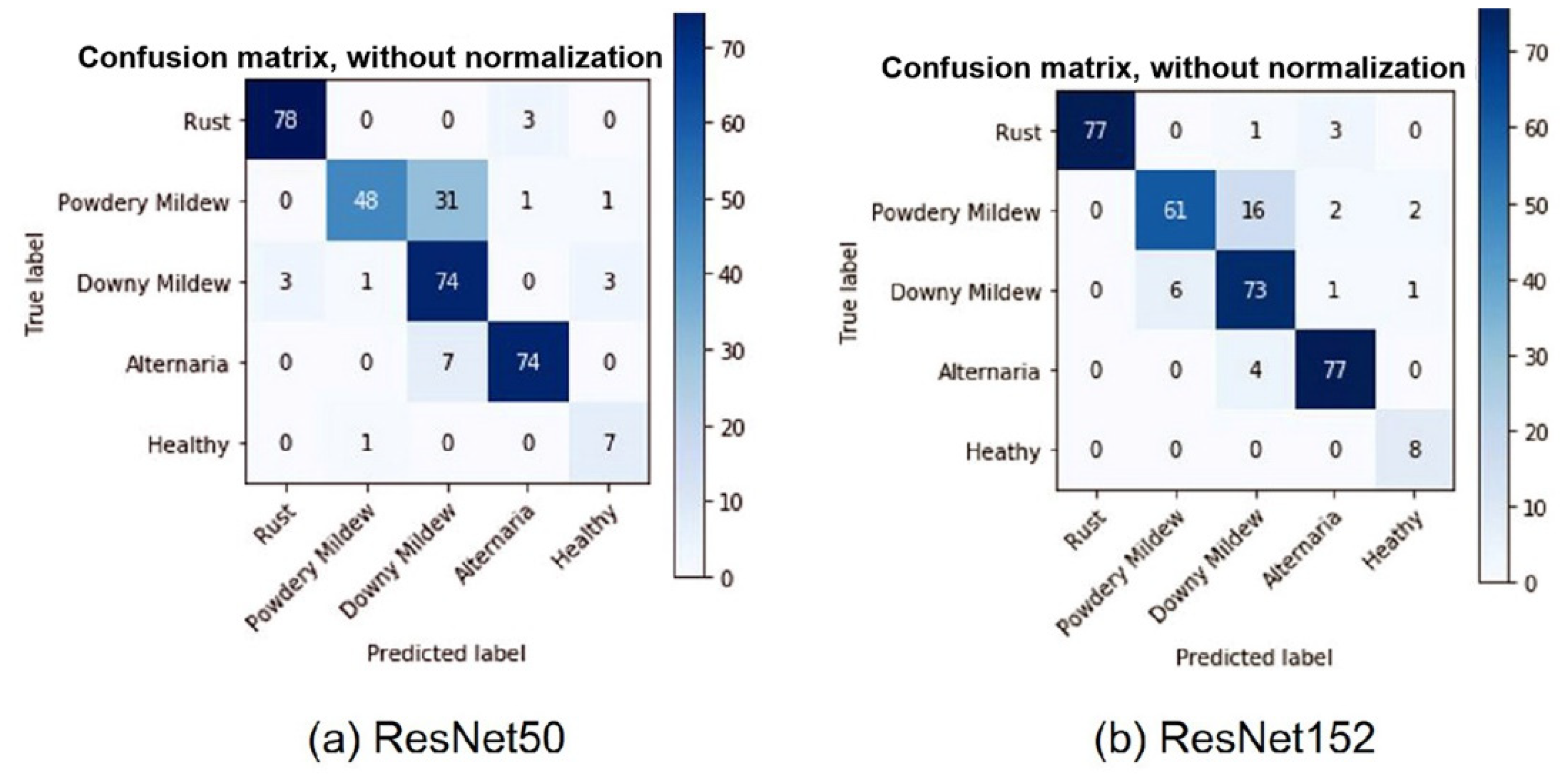


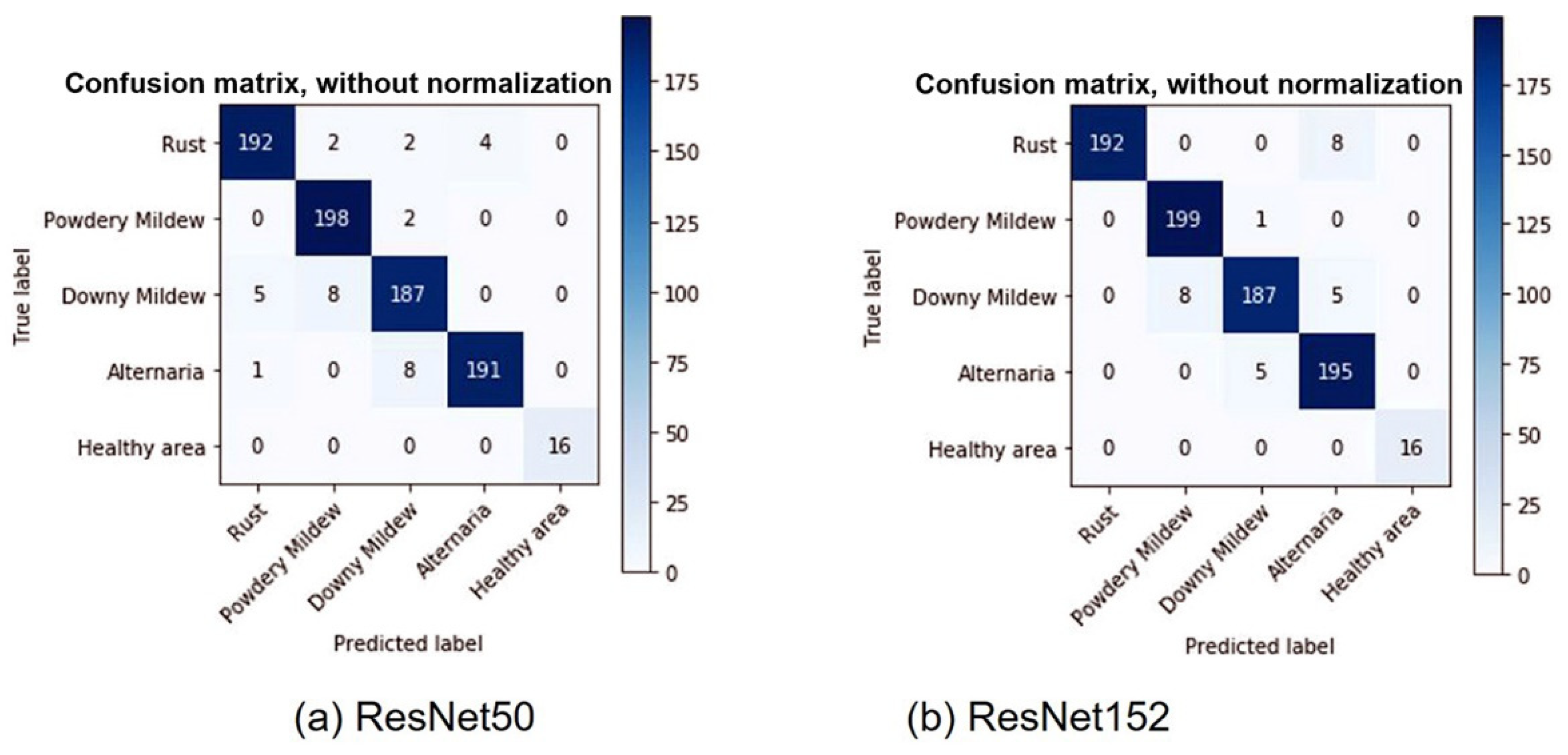
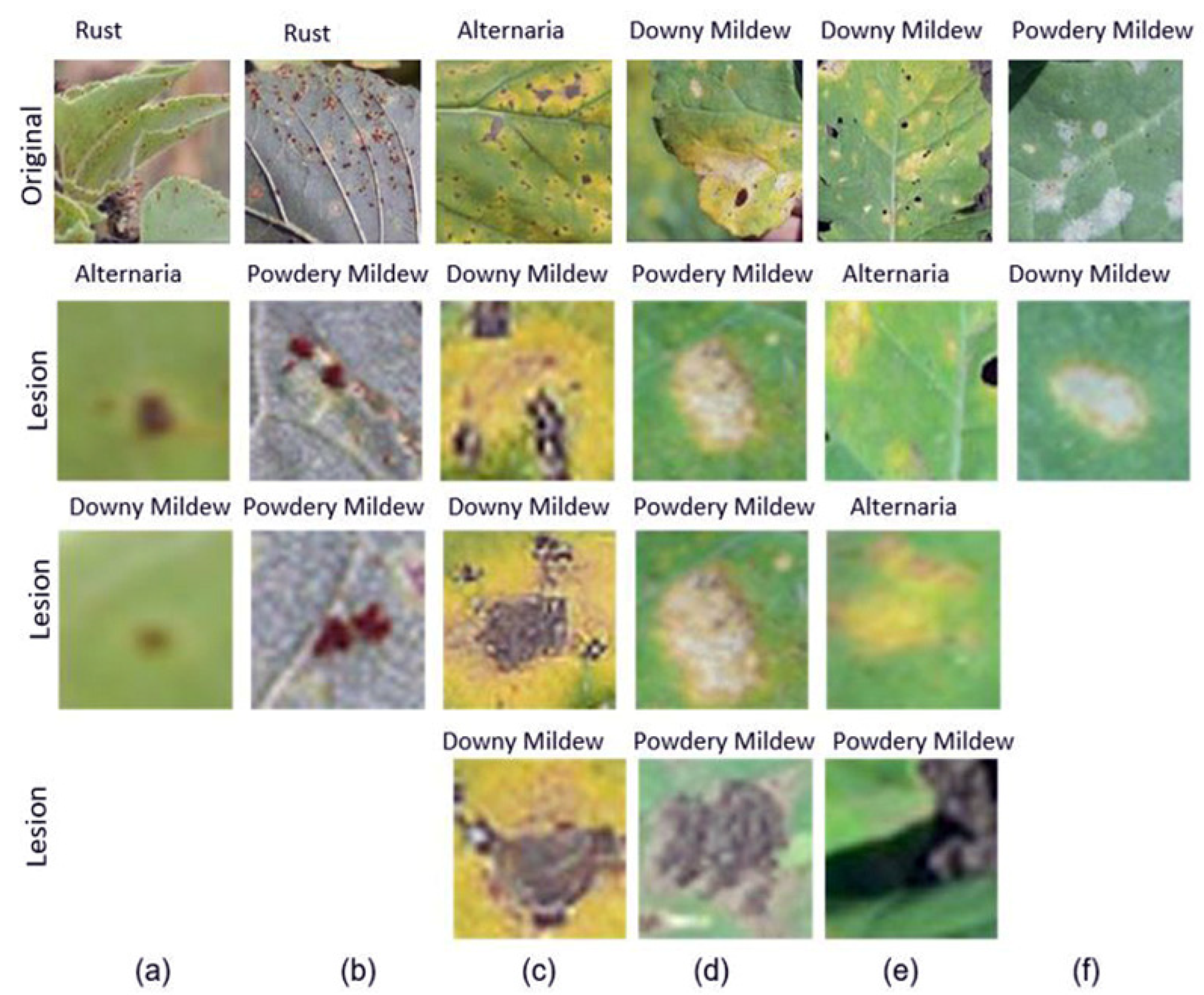
| Host | Class | No. of Images for Training and Validation | No. of Images for Testing |
|---|---|---|---|
| Sunflower | Rust | 300 | 81 |
| Sunflower | Powdery mildew | 300 | 81 |
| Sunflower | Downy mildew | 300 | 81 |
| Sunflower | Alternaria leaf blight | 300 | 81 |
| Sunflower | Healthy leaves | 300 | 8 |
| Host | Class | No. of Images for Training and Validation | No. of Images for Testing |
|---|---|---|---|
| Sunflower | Rust | 600 | 200 |
| Sunflower | Powdery mildew | 600 | 200 |
| Sunflower | Downy mildew | 600 | 200 |
| Sunflower | Alternaria leaf blight | 600 | 200 |
| Sunflower | Healthy leaves | 600 | 16 |
| CNN | Image Size | Epochs | Train. Loss | Valid. Loss | Training Accuracy | Valid. Accuracy |
|---|---|---|---|---|---|---|
| ResNet50 DS1-V1 | 224 × 224 | 6 | 0.056 | 0.303 | 0.991 | 0.863 |
| ResNet152 DS1-V1 | 224 × 224 | 6 | 0.065 | 0.246 | 0.984 | 0.92 |
| ResNet50 DS1-V2 | 224 × 224 | 6 | 0.069 | 0.387 | 0.987 | 0.858 |
| ResNet152 DS1-V2 | 224 × 224 | 6 | 0.049 | 0.307 | 0.993 | 0.903 |
| ML Model/Dataset | Accuracy |
|---|---|
| ResNet50/DS1-V1 | 92.59% |
| ResNet152/DS1-V1 | 91.97% |
| ResNet50/DS1-V2 | 84.63% |
| ResNet152/DS1-V2 | 89.15% |
| CNN | Image Size | Epochs | Train. Loss | Valid. Loss | Accuracy | Valid. Accuracy |
|---|---|---|---|---|---|---|
| ResNet50 DS2-V1 | 224 × 224 | 6 | 0.025 | 0.091 | 0.996 | 0.967 |
| ResNet152 DS2-V1 | 224 × 224 | 6 | 0.014 | 0.090 | 0.998 | 0.969 |
| ResNet50 DS2-V2 | 224 × 224 | 6 | 0.015 | 0.087 | 0.999 | 0.969 |
| ResNet152 DS2-V2 | 224 × 224 | 6 | 0.012 | 0.074 | 1 | 0.98 |
| ML Model/Dataset | Accuracy |
|---|---|
| ResNet50/DS2-V1 | 95.12% |
| ResNet152/DS2-V1 | 93.25% |
| ResNet50/DS2-V2 | 96.0% |
| ResNet152/DS2-V2 | 96.6% |
| Host | Class | Test Images | Unclassifiable | Classified Correctly | Classified Incorrectly | Accuracy per Disease |
|---|---|---|---|---|---|---|
| Sunflower | Rust | 81 | 3 | 69 | 9 | 88% |
| Sunflower | Powdery mildew | 81 | 34 | 15 | 32 | 31% |
| Sunflower | Downy mildew | 81 | 20 | 45 | 16 | 73% |
| Sunflower | Alternaria leaf blight | 81 | 2 | 78 | 1 | 96% |
| Host | Class | Test Images | Unclassifiable | Classified Correctly | Classified Incorrectly | Accuracy per Disease |
|---|---|---|---|---|---|---|
| Sunflower | Rust | 81 | 7 | 63 | 11 | 85% |
| Sunflower | Powdery mildew | 81 | 24 | 36 | 21 | 36% |
| Sunflower | Downy mildew | 81 | 6 | 66 | 9 | 88% |
| Sunflower | Alternaria leaf blight | 81 | 0 | 74 | 7 | 91% |
Publisher’s Note: MDPI stays neutral with regard to jurisdictional claims in published maps and institutional affiliations. |
© 2022 by the authors. Licensee MDPI, Basel, Switzerland. This article is an open access article distributed under the terms and conditions of the Creative Commons Attribution (CC BY) license (https://creativecommons.org/licenses/by/4.0/).
Share and Cite
Dawod, R.G.; Dobre, C. Automatic Segmentation and Classification System for Foliar Diseases in Sunflower. Sustainability 2022, 14, 11312. https://doi.org/10.3390/su141811312
Dawod RG, Dobre C. Automatic Segmentation and Classification System for Foliar Diseases in Sunflower. Sustainability. 2022; 14(18):11312. https://doi.org/10.3390/su141811312
Chicago/Turabian StyleDawod, Rodica Gabriela, and Ciprian Dobre. 2022. "Automatic Segmentation and Classification System for Foliar Diseases in Sunflower" Sustainability 14, no. 18: 11312. https://doi.org/10.3390/su141811312
APA StyleDawod, R. G., & Dobre, C. (2022). Automatic Segmentation and Classification System for Foliar Diseases in Sunflower. Sustainability, 14(18), 11312. https://doi.org/10.3390/su141811312









